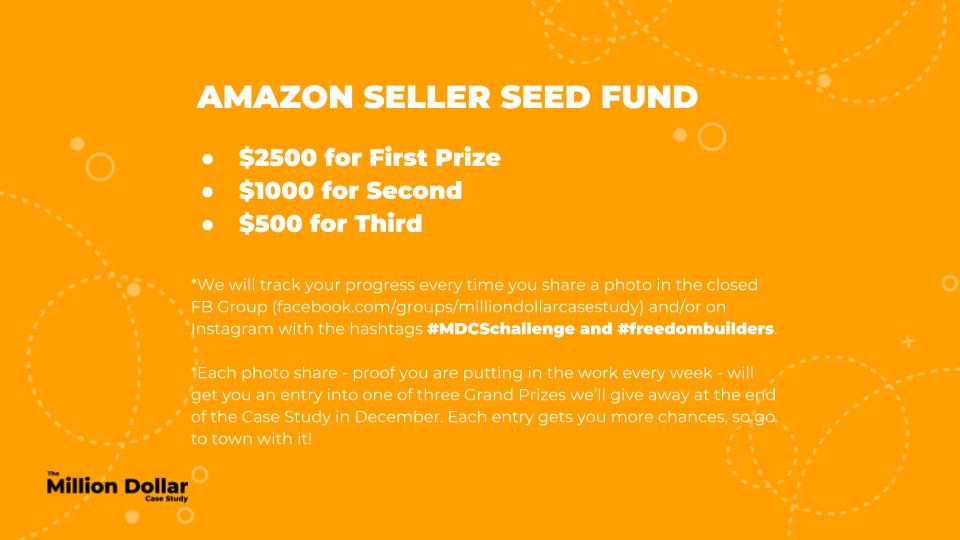Blog: Million Dollar Case Study: Advanced Amazon Product Research in 4 Simple Steps
Million Dollar Case Study: Advanced Amazon Product Research in 4 Simple Steps
- This is the second episode of the fourth season of the Million Dollar Case Study: Advanced Amazon Product Research in 4 Simple Steps.
- This episode dives deeper into product research using Jungle Scouts Web App and Chrome Extension.
- Watch the video and keep reading to learn the 4 Steps to Amazon FBA Success.
- Exclusive Jungle Scout discount offered at the end!
How to narrow down your Amazon product research in 4 Simple Steps?
How to differentiate your product from the competition with CDI (Customer-Driven Innovation™)?
We’re covering all of this today in our second episode of the Million Dollar Case Study. Watch the video, keep reading and don’t forget to claim your exclusive Jungle Scout discount!
Subscribe to the Million Dollar Case Study list here, so you never miss an episode!
Before you get started, if you’re not already using Jungle Scout, you will need to get a Jungle Scout subscription to follow along with us and complete your product research.
To help you out, we’ve put together a Jungle Scout discount code that gives you more than 30% off Jungle Scout – both the Web App and Chrome Extension! Plus, you get a pretty fantastic FREE t-shirt to go with it.
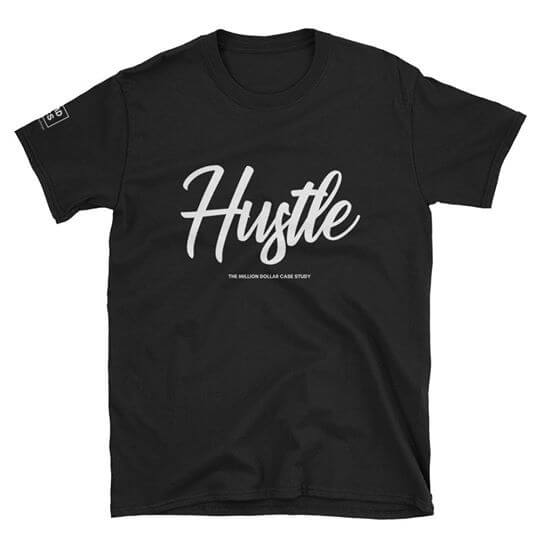
Hey Freedom Builder!
Welcome back to the Million Dollar Case Study. If you’re not familiar with the Million Dollar Case Study, this is where we build and scale an Amazon business to a million dollars in revenue. This is Episode 2 and by the end of today’s episode, you’re going to know exactly how to find a product customers want to buy.
Since last week, I went into Jungle Scouts Web App Product Database Tool, entered the filters outlined in Episode 1 and began tracking products that I found interesting using the Product Tracker.
Before we dive into some real-time examples, I want to share the 4 Step process I used to narrow down my long list of Amazon product research ideas. Remember, at this phase of the process we are looking to fill up our Product Tracker with as many ideas as possible and once we’ve maxed out our Product Tracker (which I did), then and only then, we can begin to use this 4 Step Test.
So, today I will be sharing the good, the bad, and the ugly. 😃😱
STEP 1: NARROW DOWN PRODUCT IDEAS
We want to remove anything with the following:
- High competition or high seasonality
- Anything that’s easily breakable like glass
- Any consumable items like food, drinks, supplements, or topicals
- Complex items like electronics or anything with lots of moving parts
- Any items that are potentially high liability like a kid’s car seat, or a life vest
- Anything that’s trendy or faddish (fidget spinners are a good example of that)
- Lastly, I want to stay away from legal troubles, this will be anything that is patented or supposed to be licensed like a t-shirt or hat from your favorite sports teams.
STEP 2: READ CUSTOMER REVIEWS ON AMAZON
After we narrowed down our product ideas using Step 1, Step 2 is to use the Customer Driven Innovation™ method, which means we’re going to be reading the customer reviews on Amazon and figuring out what people don’t like about these products. The best thing to do is start with the reviews that are 1 or 2 star ratings and figure out what those upset customers didn’t like.
CUSTOMER-DRIVEN INNOVATION™
This product research strategy is halfway between an invention and private labelling. It leverages Jungle Scout to find products that sell well, but are lacking key elements or features to make them truly appealing to users. It involves looking at sales, ratings and reviews.
STEP 3: LIST CUSTOMER COMPLAINTS
Step 3 is going to be to list out the customer complaints. A great place to do this is inside of Jungle Scouts Web App Product Tracker. There is a note section for each product that you’re tracking. If you’re not using the Product Tracker, you can of course use a spreadsheet or an old fashioned pen and paper.

STEP 4: INNOVATE
Now that you know what the customers want out of the products they’re buying, Step 4 is to make those innovations.
Don’t be intimidated, I’m sure what a lot of you guys are thinking right now is, “wait a second, I’m not an engineer, I’m not an inventor, I can’t do computer generated product drawings”. The truth is you don’t have to be able to do any of these things, or have any experience in this area.
Sometimes it can be beneficial to hire a Computer Aided Design master to make 3D renderings for you, however, often times you can just work directly with the factory to make these improvements.
You need to communicate with them what you would like to improve on, any ideas you have for making these improvements, and listen to see what they have to say about those improvements. They may say, “Well we can’t quite do that, but we could do this instead” which can get you closer to your final design and ultimate product goal.
And through an iterative, collaborative process, you can work with the factories to make these improvements without giving them an official set of drawings.
Let’s go ahead and dive in and see what kind of Amazon product research ideas I came up with and we’ll start to drill down on what makes a good product versus a bad one.
What do you think? Thumbs Up 👍 or Thumbs Down 👎
Alright, as you can see here, in my Product Tracker Tool I have several custom tabs that I created (FYI: at the time of this writing you are limited to 19 custom tabs and I strongly advise you max these tabs out and add at a minimum 5 competitor products to each tab) as well as some un-categorized products.:
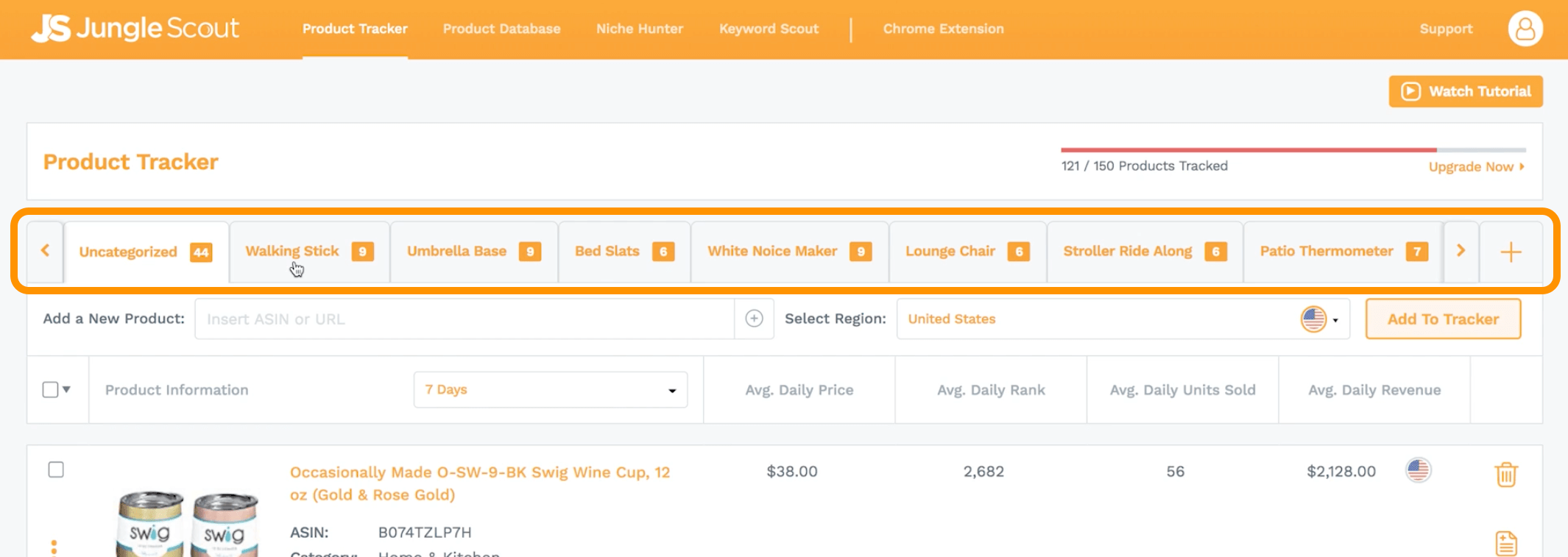
Let’s dive into the different tabs I created starting with the Walking Stick tab. Originally I liked this product because it’s a little weird, it’s not something that the average seller is going to go after, so I’m trying to think outside the box.
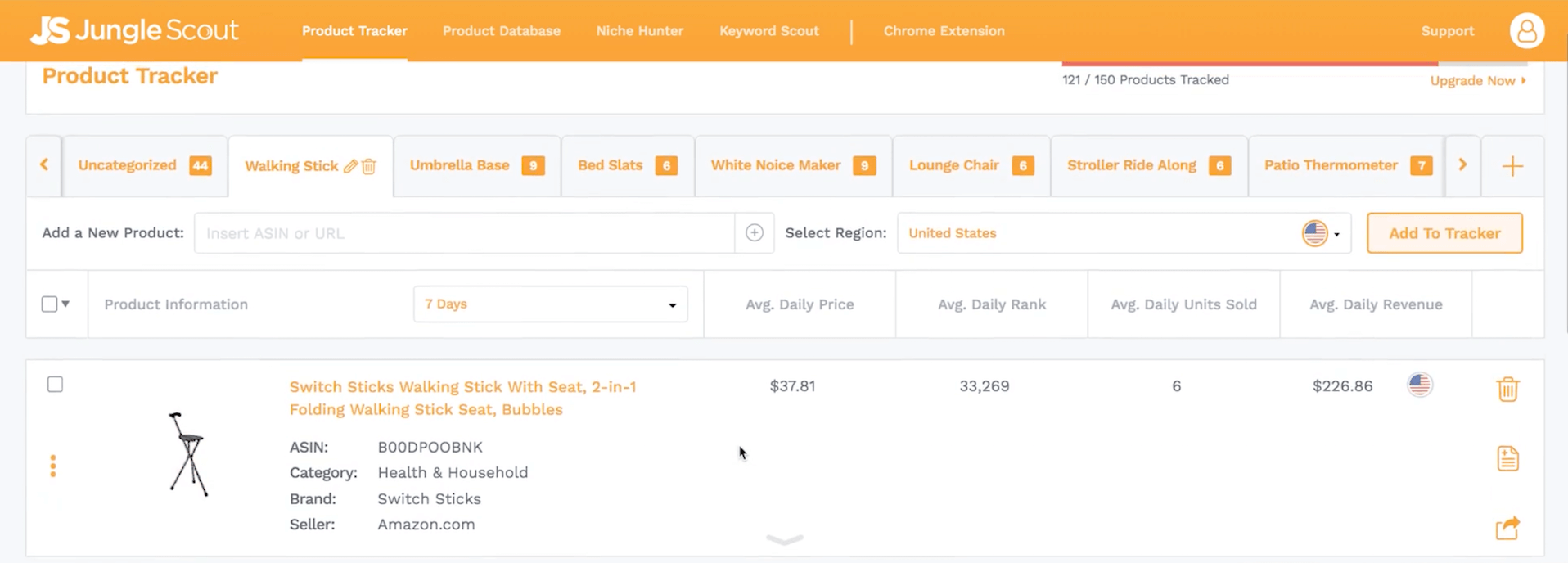
I’m going to pull it up on Amazon and run the Jungle Scout Chrome Extension.
It looks like the sales are decent and if I add up the sales for the top 10 vendors I get the total monthly sales of 2,273, slightly above our minimum threshold goal of 2,000. Not bad.
What do you think?
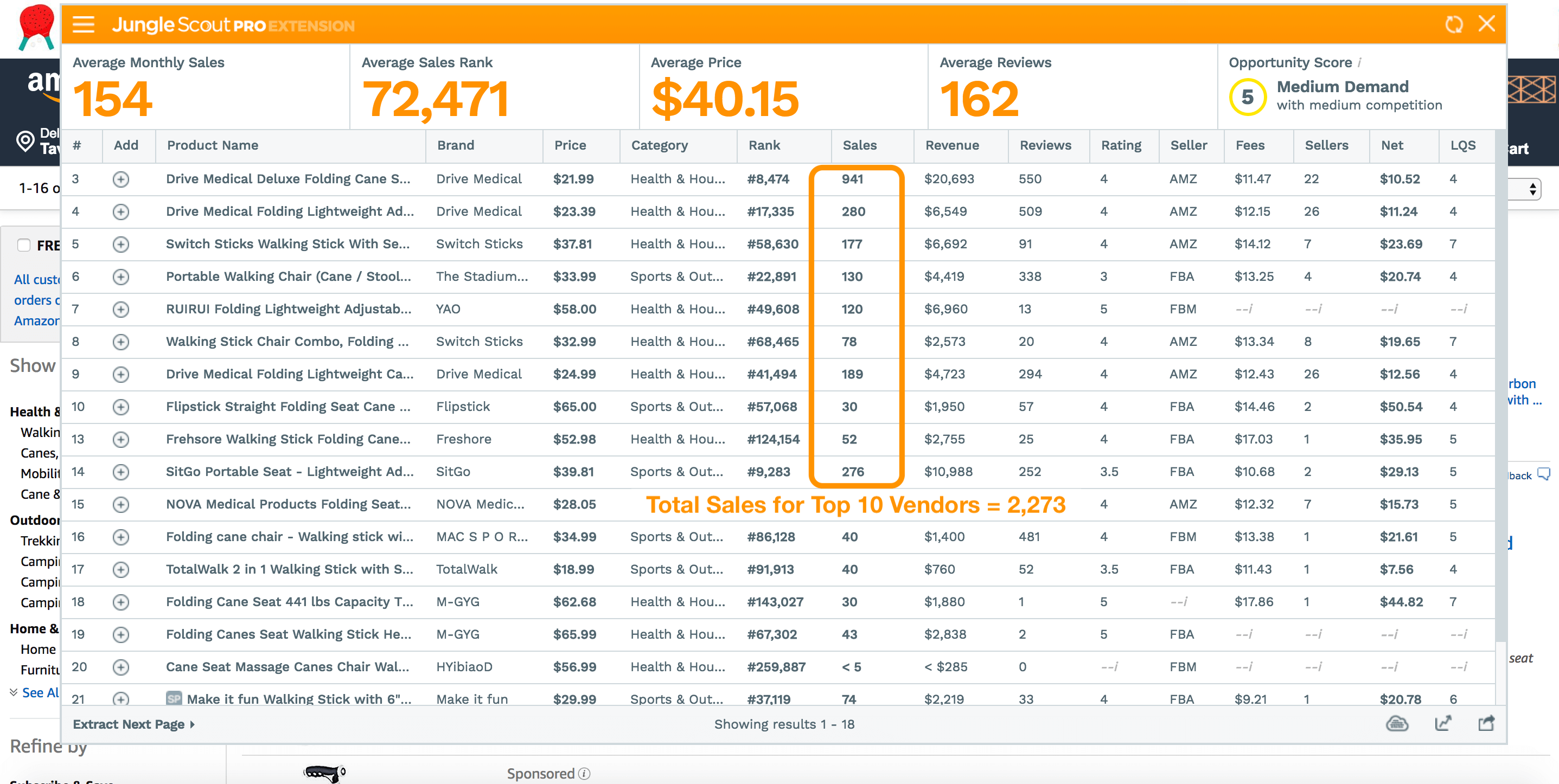
Here’s my thoughts so far. There are a few sellers with not many reviews. I see three sellers with under 50, however the ones that do have a lot of reviews do have quite a few. The ratings, most people are getting four stars, so some room for improvement, but not a ton of room for improvement.
The other thing I don’t like about this product idea is earlier when I was giving you the criteria to look for, one of the things that I said was to stay away from products that potentially have a high liability, and to me this one falls under that category.
So this product gets a Thumbs Down 👎
Let’s go ahead and go into my second tab. Here I have these Umbrella Bases, I think that this will be a little safer. Wouldn’t you agree?
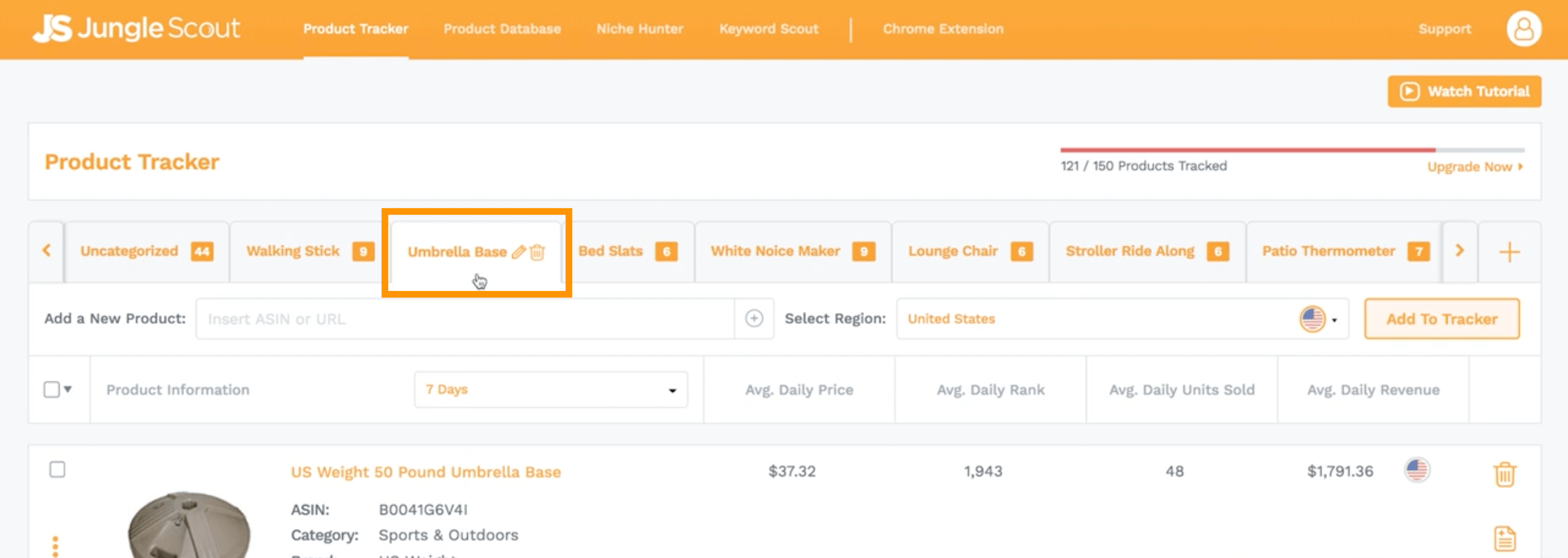
When I look through these, there’s tons of sales, I’m seeing 48, 75, 180 a day, which is a ton of sales. Let me pull it up on Amazon with the Chrome Extension.
What do you think?
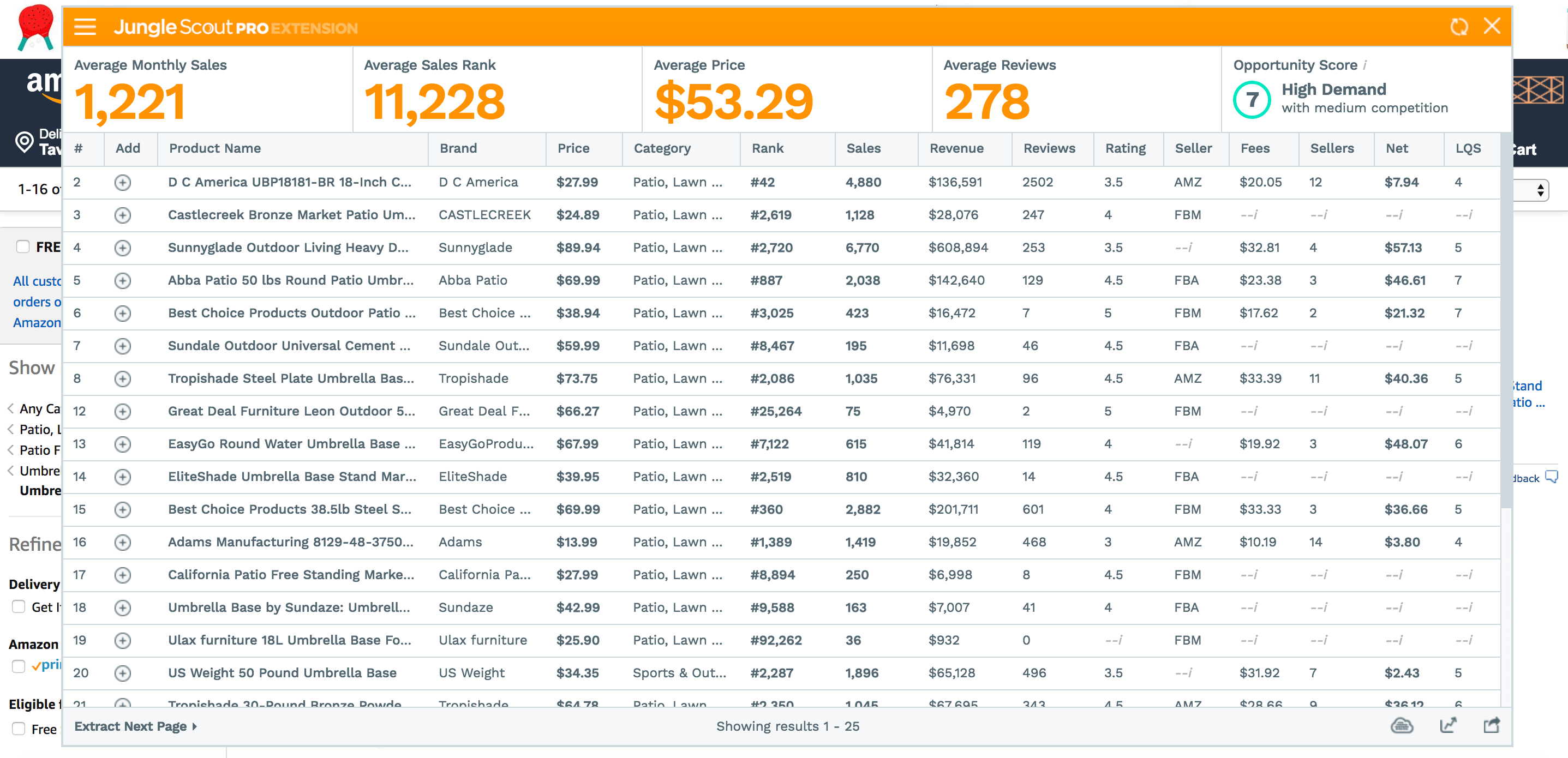
What I’m seeing here is a ton of sales! Among the top ten sellers we are well above our 2,000 minimum per month threshold, to be exact 17,969 sales, which is an insane demand! If I look at the number of reviews, it is fairly competitive though. One person has 54 reviews, but a lot of people have hundreds. The top seller has almost 2,502. There probably is room for improvement here, there’s multiple people who are selling such as the top seller and that seller only has 3.5 stars but that seller is selling 4,800 per month, which is crazy!
One concern I have about this product is it’s probably fairly seasonal, so there’s two ways you can check seasonality in the Chrome Extension. Your first option is by clicking on the number of sales and it will show you how many sales this has made each month for as long as we have been tracking it.
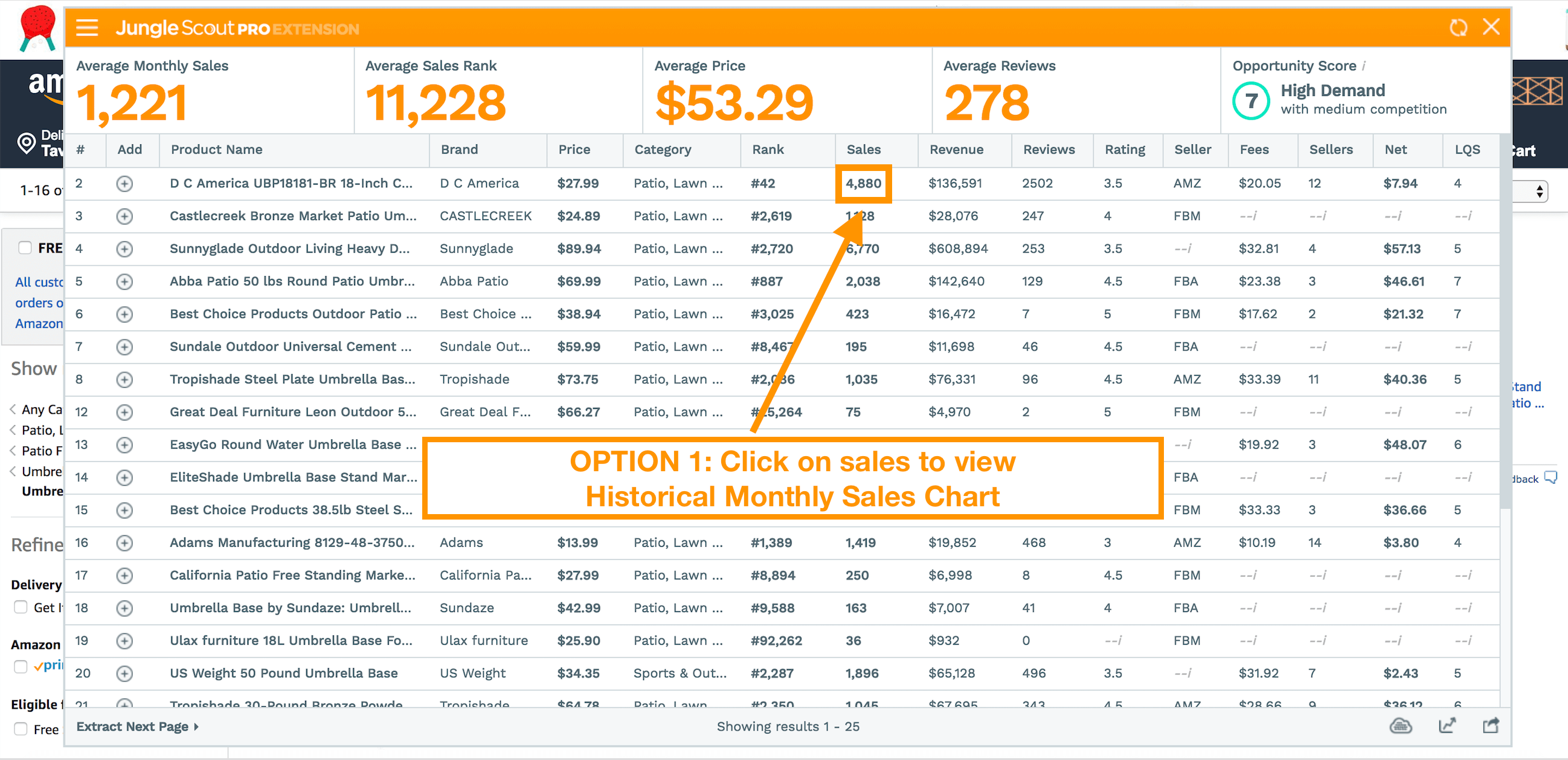
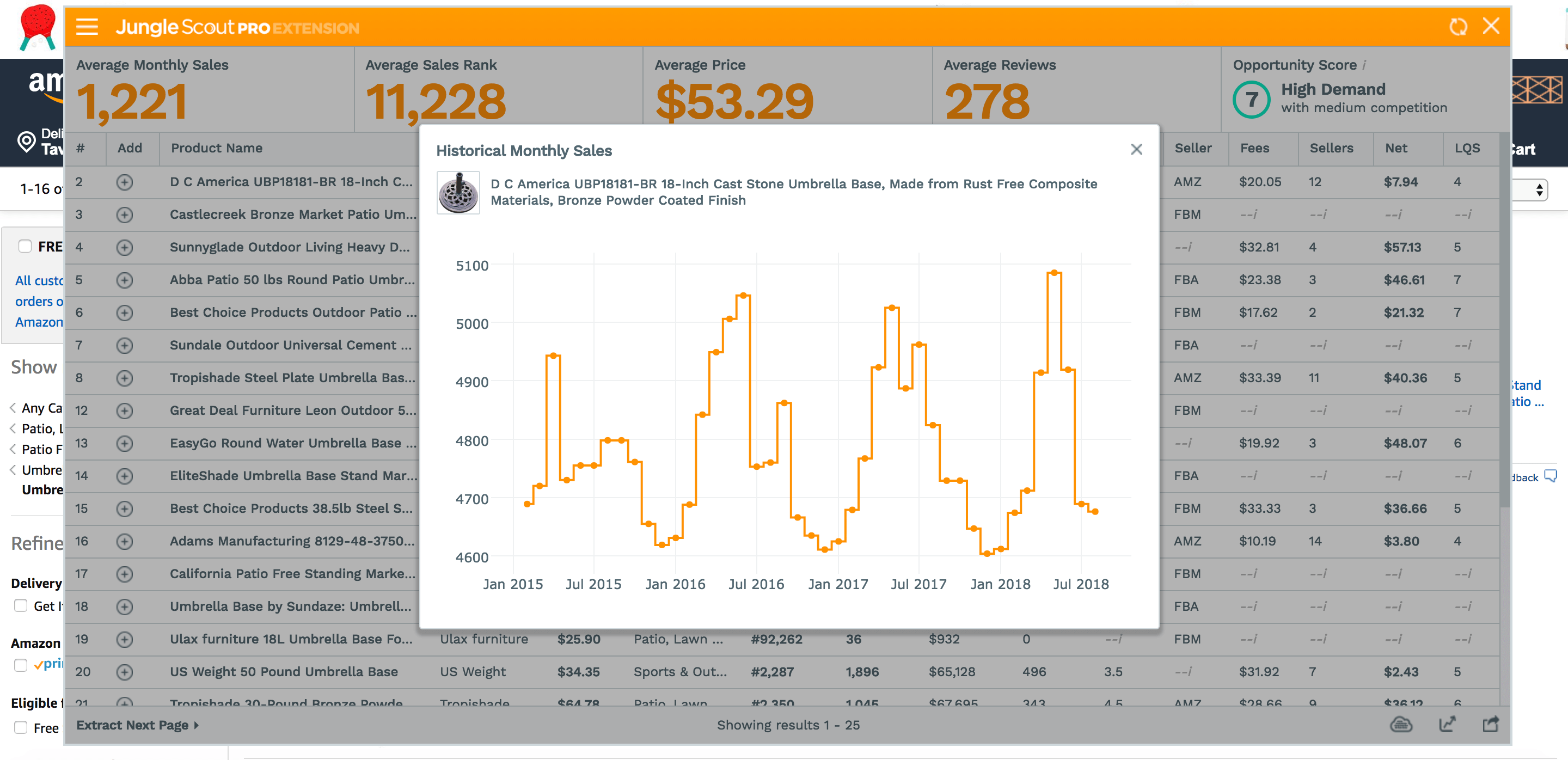
Alternatively, option 2 is to click on the chart icon on the bottom right corner and this shows you how this product has been trending over the years on the Google Trends Report. This isn’t quite as good of an indicator as the sales on Amazon, but I just wanted to show you one other way to do your product research.
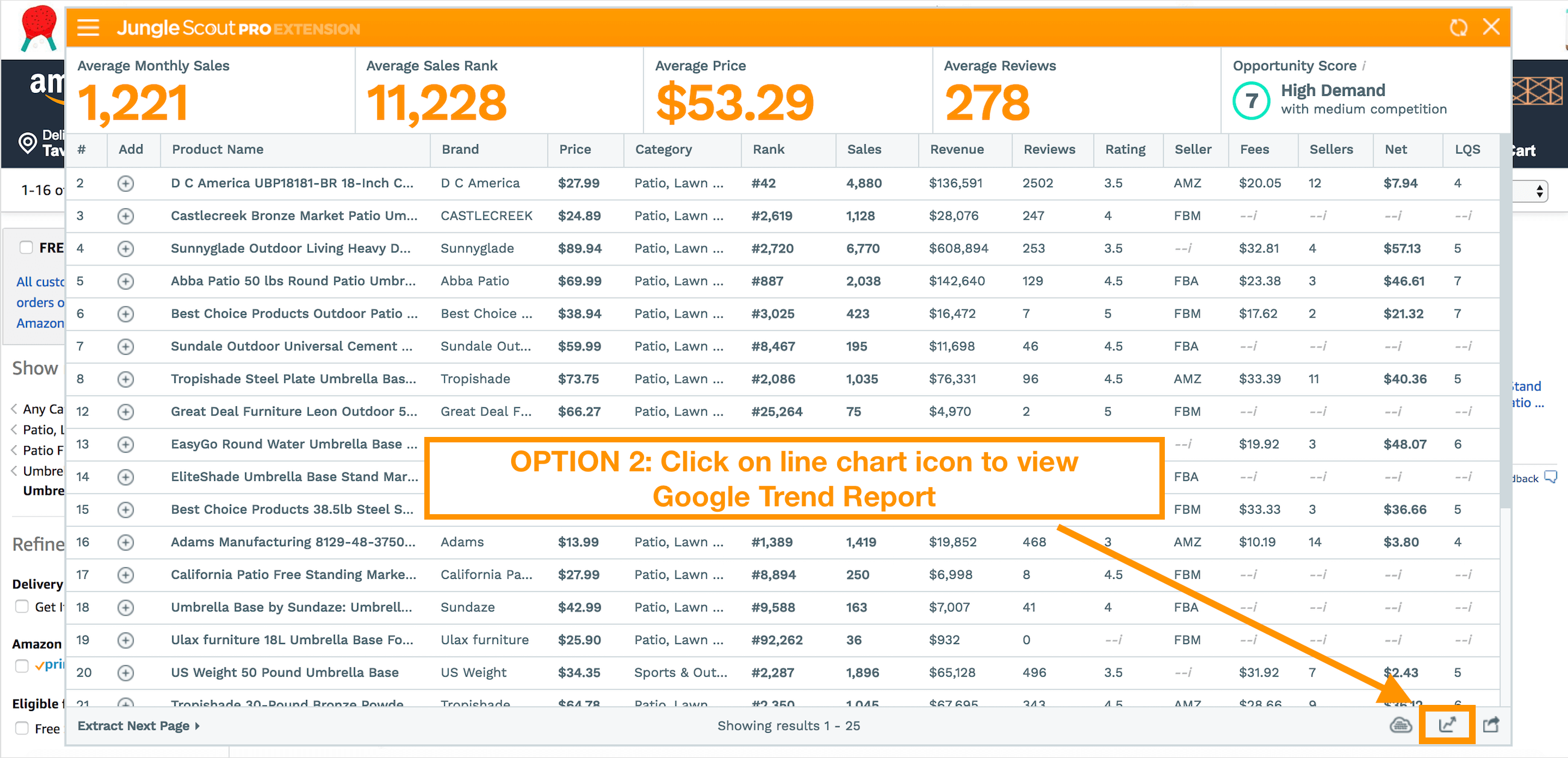
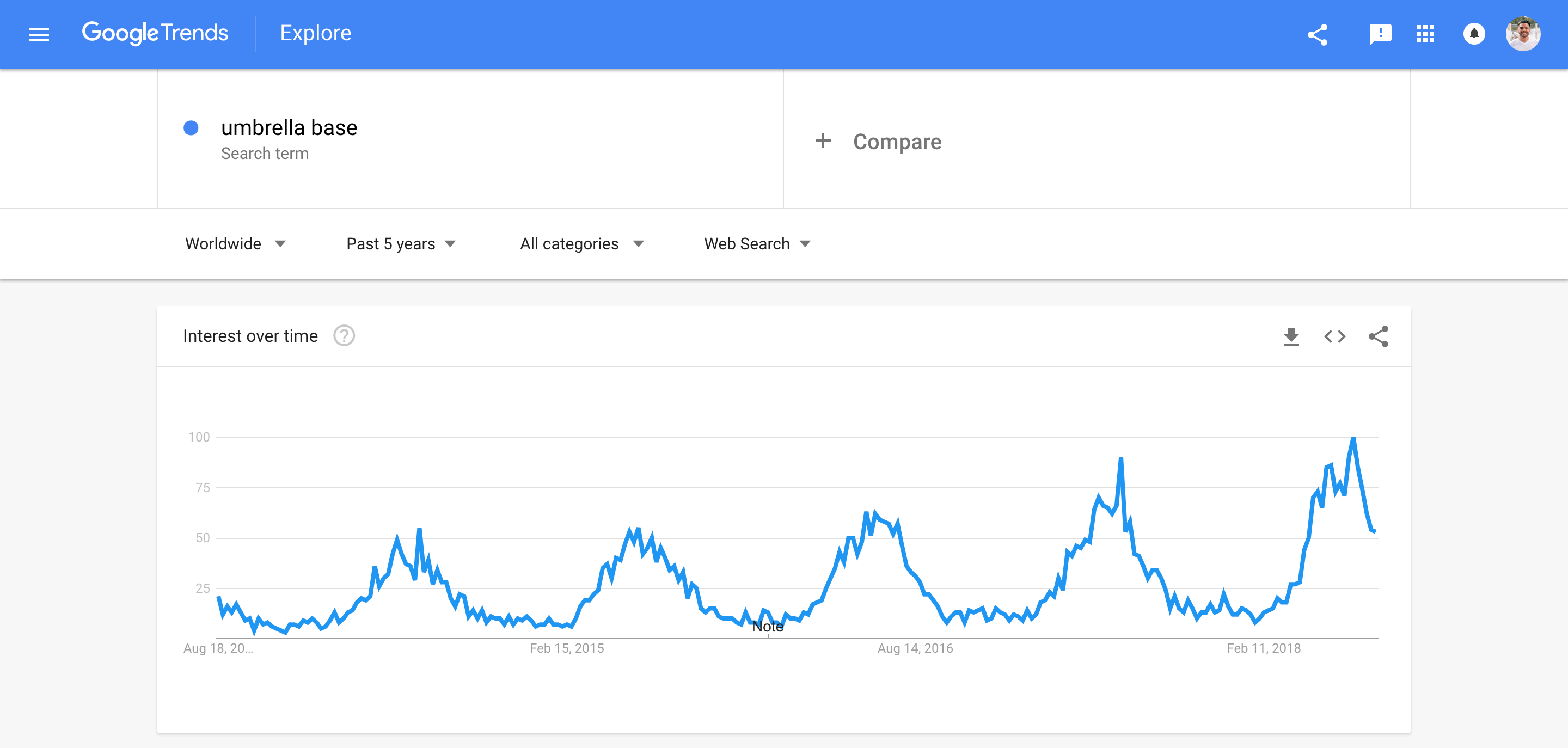
When I look at this, I can clearly see that in the summer months, May, June, July, August, the sales are very high, and it looks like the sales drop significantly from that point forward through the winter.
So I think I’m going to have to say I do not like this product due to the relatively high seasonality.
So this product also gets a Thumbs Down 👎
Wow, I’m striking out! Not to worry because the more I HUSTLE the closer I am to that winning product!
💡PRO TIP: As you are validating your product ideas you’ll want to ensure that you are documenting your observations and making notes in the Product Tracker Tool, you can do this by clicking on the paper icon on the right side of your product listing. A little red dot appears on the icon to remind you that you have a note in that product.
Let’s go ahead and look into my next product, which are these patio thermometers:
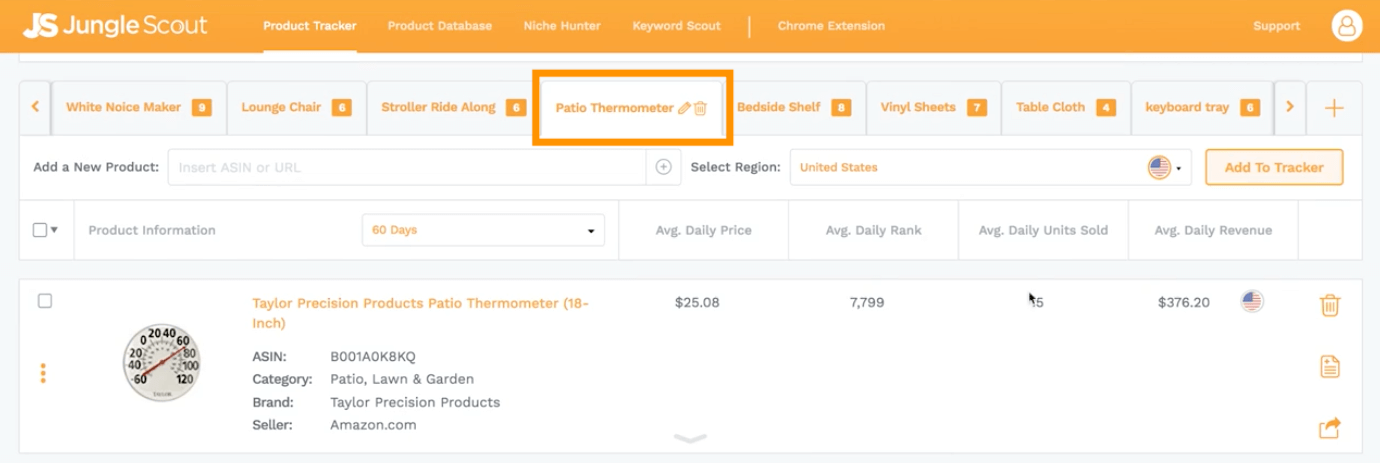
So, right away I see that sales are pretty strong: 15, 25, 20, 15 per day. This product definitely looks fairly simple, fairly lightweight, and easy to ship, so I think it checks all those boxes. I doubt there’s any liability issues associated with this, especially because they don’t put mercury in thermometers anymore. But, let’s go ahead and look at it on Amazon and run the Chrome Extension to see what we find out there.
What do you think?
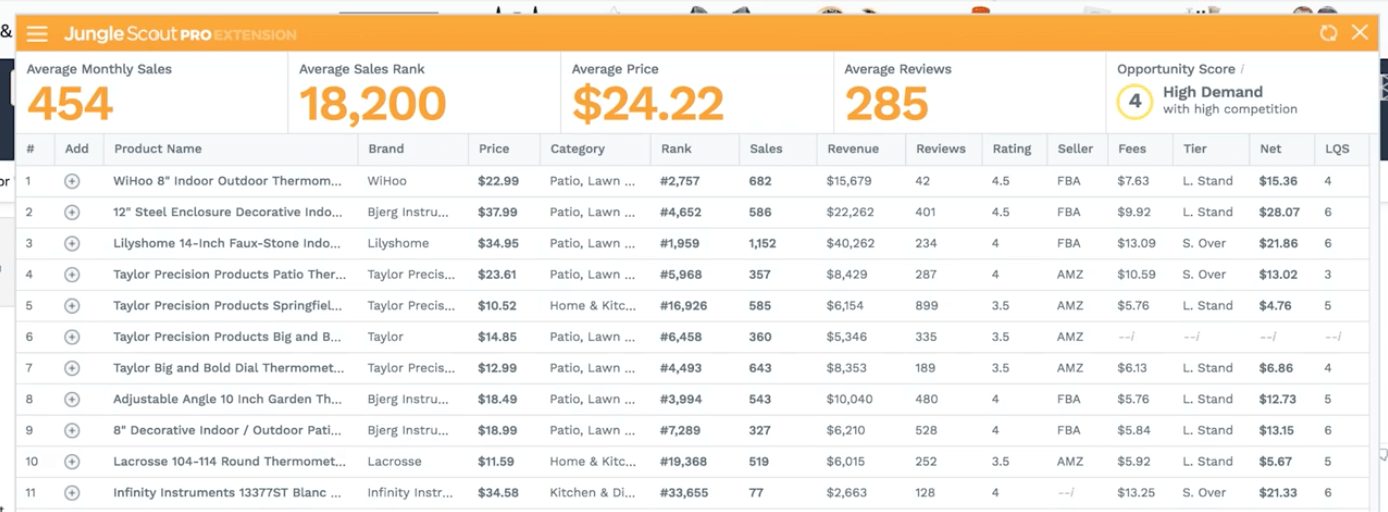
After running the Chrome Extension, I’d say it’s at a good price point. Sales look strong and I really like that they’re distributed well throughout the different listings. The reviews are pretty competitive. There’s quite a few reviews on these products, however, one thing that I do like, or I’m not totally scared away yet, is there’s also a lot that get rated poorly, even though they’re selling well. And again, I’m sure this is why this product showed up in your product database search. I see there’s three sellers here, selling 585, 360 and 643, which is 10 to 20 units per day and they all have 3.5 ratings.
So again, this product is pretty competitive, however, I do like that sellers are getting poor ratings, yet they’re still selling well. Again, that’s a great product to do some Customer Driven Innovation™ on. Let’s hold on to this one.
So this is a product I would say to Thumbs Up 👍(for now)
Phew, I was getting worried that all my product research was turning up duds! 😅
💡PRO TIP: Be sure to watch the video that accompanies this blog post to get additional product research insights from the Man, the Myth, the Legend, and my Entrepreneurial Man Crush – Greg Mercer.
I think I saved the best for last. This is my personal favorite and it’s this keyboard tray. This is an interesting product because it falls in that “weird” category, because it is a clamp-on keyboard tray, so it’s not your standard bolt/screw-on keyboard tray.
What do you think?
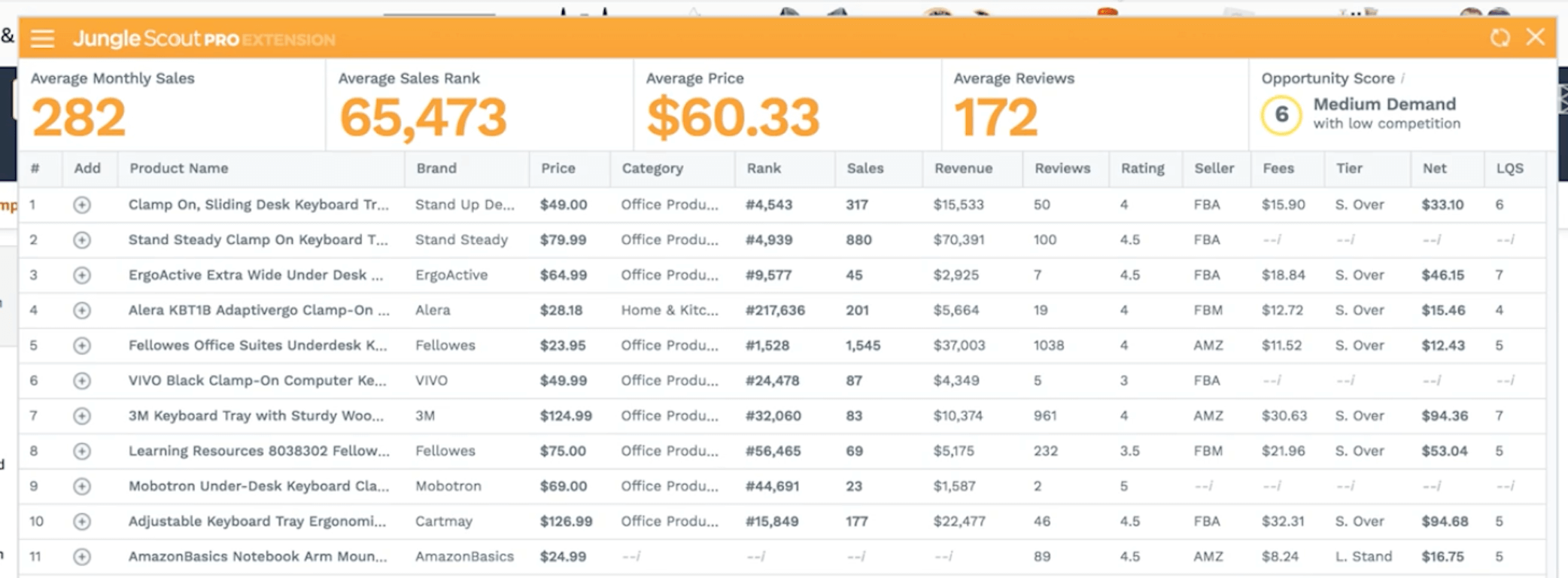
Prior to finding this product on the Product Database I don’t think I’ve ever actually seen one of these keyboard trays before so it’s definitely something unique. It looks like the sales inside of the Product Tracker are solid. Let me go ahead and pull it up on Amazon and run the Chrome Extension. Right way, I see it’s at a pretty good price point. The minimal price point there is about 24 dollars and it goes up to 50, 80 or even over 100 dollars.
The sales look pretty solid. In the top ten, looks like there’s roughly two thousand units per month, maybe more.
The number of reviews are low. I’d say this one is low competition. 50 reviews, 7, 19, 5, so plenty of sellers that don’t have many reviews, which signifies to me it’s a pretty young and immature niche. Something that’s easier to enter. It looks like there are a few sellers with bad reviews. Their products aren’t selling quite as well.
Overall, I like this product idea. I do wish there were a few more sales, however, I think it does sell well enough for me to go into. I like how it’s not very competitive, and I also like how there is room for improvements for this particular product. Of course, I haven’t dug into it yet to see what kind of improvements people want to make but it’s something worth exploring further.
So I’m going to say Thumbs Up 👍(for now)
Next Steps…
So the next step from here is monitoring your Product Tracker. You can view the sales on a day-to-day basis and what this does is it removes any artificial inflations due to sellers running a promotion or anything else along those lines.
I’d also recommend that you take good product notes inside of the Tracker. So again, click that little paper icon on the right of your product listing and add whatever notes come to mind because this is a great place to keep all of those thoughts organized.
There’s two main things left to consider on how to narrow down your product ideas to find the one. The first one is going to be profit margins, and unfortunately we’re not going to know our true profit margins until after we speak with the factories and start to get price quotes. In order to get price quotes from the factories, we’re going to need to know what type of improvements we want to make on each of these products.
Next week we can figure out which types of improvements would be easy for us to make and which ones would probably be more difficult. We can then put that together in a package to start getting quotes from factories so we can figure out what the profit margins would be associated with each of these products.
Now, it’s YOUR TURN!
First, you need to get access to Jungle Scout. To help you get started, we’re offering you 30% off the Jungle Scout Web App and the Extension, both tools that I showed you today.
Next, you’ll need to start doing some research of your own. Every week, we’ll be giving you your Action Items and Weekly Workbook and exclusive hacks to make the most of your MDCS journey.
Get your FREE MDCS Workbook!
Here’s what you could be eligible to win at the end of the MDCS! We’ll be drawing for names and the more photos you post and share as the weeks go on, the more chances you get.
